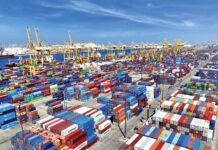
The past few years has seen the normal ebb and flow of world economics fluctuate wildly. The trigger was the 2008 financial crisis that we’re still feeling the effects of today. With many companies worldwide continuing to see margins shrink, the pressure to perform is on. Combined with the rise and importance of e-commerce, new emerging markets, and a seismic global shift in demand patterns, many are turning to logistics providers to help them streamline and better control their operations.
Above all, having a flexible and visible supply chain has become imperative in today’s business environment. However, getting there requires that companies prioritize supply chain operations and tightly align with partners for all business functions. This flexibility and vision is key for risk mitigation and allows for strong growth in the future.
For a deeper insight, we spoke with Mr. Hans Elmegaard, Senior Vice President, Global Head of Strategic Business Development at Panalpina, one of the largest third party logistics providers (3PLs) in the world. His first-hand experiences show how strong partnerships between companies and logistics providers can lead to success.
Flexibility is Pertinent for Success
Supply chain management isn’t a new phenomenon, and originally emerged with the goal of organizing companies and suppliers together to increase results. The roots of this flexibility can be seen through the different stages retail markets have taken throughout the last century. Starting from the early 1900’s with small corner shops, to the mid-century and the rise of big box stores, to today where everything is focused around e-fulfillment. Supply chains have had to learn to adapt, and the current focus is on serving customers who would like to have products available in stores, to pick up, or be delivered right to their door no matter where they live. Consumer behaviors have been the true driving force behind all these changes.
Mr. Elmegaard said, “All retailers are trying to have a direct influence on the supply chain, but a rigid supply chain might not be able to cope. That’s why certain fundamental changes to a supply chain need to be first looked at from a more strategic level, rather from a cost perspective level. While cost is of course important, first having flexibility in the system and the ability to adapt to change is key. The way companies have set up their logistics platforms today is not necessarily how the platforms will need to be run in two years from now, depending on what their customers or consumers want in the end. They have a direct influence on the supply chain; you don’t know what will change tomorrow, so flexibility is absolutely critical.”
“To be successful, an organization needs to be honest with itself and be able to understand their strengths and weaknesses”
Visibility for the Road Ahead
Organizations can get bogged down with all the requirements for running a business, especially in an age of global markets. That’s why developing close relationships with 3PLs can add real value to a company’s supply chain operations. 3PLs offer a competitive advantage by improving service and minimizing risk.
Mr. Elmegaard said, “To be successful, an organization needs to be honest with itself and be able to understand their strengths and weaknesses. We’re past the age of companies being able to do everything in-house by themselves. You need to be able to pay attention to so many different aspects of a business that a high priority must to be placed on visibility within the supply chain. It starts with discussing and learning about a company’s current supply chain. We need to follow our customers’ markets in order to know how to proceed in the future. Overall, you need to understand the customers’ objectives to formulate a plan of action. You need to get to a deep level to understand what the drivers are behind decisions and success of our customers.”
“I’ve found that companies that are able to use supply chain as an enabler for the entire business model are the ones ahead of the game. There’s still a lot of companies running with the idea that transportation is just a cost. If you work in a global environment you cannot avoid logistics activities. Meaning, if you’re able to take advantage of the supply chain, you can stand out from the pack. Making supply chain and logistics a key part of the business and not just a side activity is where many business find success today.”
Building Strong Bonds
What started as a purely transactional based model of companies and 3PL’s working together is now evolving into much more. Forming strong collaborative partnerships and asking how best to meet the needs of a customer for their long-term success is not only good for the company; for if they succeed so does the logistics service provider. It isn’t so strange of a concept, but one that has taken years to penetrate the minds of many. The model works best when companies come asking how best service providers can meet their needs, and not for only the price of a service. Companies stand to gain better service and higher-quality, lower-cost solutions for their entire supply chain, and it’s here where the true strength of the strong bonds being built can be seen.
Logistics providers who serve as partners help companies gain greater insights into their own supply chains as well, but for a logistics provider to be more strategic with their clients they need to understand their clients better than they used to. “Those companies may have an agenda today, but could be very different in a few years,” said Mr. Elmegaard. “If we don’t understand and forecast those changes it can really become a problem for logistics providers. Being innovative for your customers is continuing to become more and more important part from a logistics provider’s perspective. I consider it to be our responsibility to bring the right ideas forward to customers; it’s a huge part of what makes a strong partnership.”
Working Harmoniously
For these relationships to blossom, a mix of IT and human support is needed. Visibility into the supply chain is imperative, and to link it all together an IT platform needs to be in place for both parties to allow them to see the bigger picture. However, as IT solutions become more important, a human touch is still needed to keep the wheels turning.
“Being innovative for your customers is continuing to become more and more important part from a logistics provider’s perspective”
Mr. Elmegaard said, “I think digitalization is good for some things, such as for clients who know what they want already and are looking for rates and transit times. It’s when we start getting into more complicated matters where having the ability to interact with a customer becomes more important. In logistics, 70% of our process is people oriented, meaning that we always need to understand the enabler for success for customers or we risk wasting time and effort pursuing solutions that lead nowhere. It’s all about having the right people to that match the right solutions. We need that balance between IT and human interaction to get the most out of a supply chain.”
Partnering with logistics providers has a proven track record of success, giving companies an opportunity to maximize their potential to build consistent and reliable global transportation services. 3PLs provide the ability to integrate service offerings and give unparalleled visibility within a supply chain, all at a fraction of the cost of a company developing their own internal logistics functions.
อัพเดตข่าวสารและบทความที่น่าสนใจในอุตสาหกรรมโลจิสติกส์ก่อนใคร ผ่าน Line Official Account @Logistics Mananger เพียงเพิ่มเราเป็นเพื่อน @Logistics Manager หรือคลิกที่นี่














